Table of Contents
Introduction:
The major artery that delivers blood from the heart through the chest and body, the aorta, has a balloon-like bulge in it called an aortic aneurysm.
Aortic aneurysms may split open or burst:
•Due to the strain of blood pumping, the layers of the artery wall may split, allowing blood to leak in between them. The action is referred to as a dissection.
•Aneurysms have the potential to entirely burst, resulting in internal bleeding. We refer to this as a rupture.
•Dissections and ruptures are the main causes of aortic aneurysm mortality.
When a blood vessel’s weak area bulges or balloons out, it develops an aneurysm. An ascending aortic aneurysm develops when a bulge forms right where the aorta emerges from the lower left pumping chamber, in the vicinity of the heart. Aneurysms can fracture or burst a blood vessel’s wall, which can be fatal if left untreated.
Types Of Aortic Aneurysm
(i) Thoracic Aortic Aneurysms
(ii) Abdominal Aortic Aneurysms
(iii) Other Types of Aneurysms
(i) Thoracic Aortic Aneurysms
In the chest, there might be a thoracic aortic aneurysm. Thoracic aortic aneurysms are more common as people get older, but both men and women are equally susceptible to them.

The usual causes of thoracic aortic aneurysms are excessive blood pressure or trauma that occurs suddenly. Thoracic aortic aneurysms can occur in individuals who have inherited connective tissue disorders such as Marfan syndrome or Ehlers-Danlos syndrome.
The following are possible warning signs and symptoms of a thoracic aortic aneurysm:
•A sudden, severe discomfort in the upper back or chest
•Breathing difficulty
•Breathing or swallowing issues
(ii) Abdominal Aortic Aneurysms
Under the chest, an abdominal aortic aneurysm develops. Thoracic aortic aneurysms are less frequent than abdominal aneurysms.

Men and persons 65 and older are more likely than other age groups to have abdominal aortic aneurysms. White people are more likely than black persons to experience abdominal aortic aneurysms.
Infection or trauma can also result in abdominal aortic aneurysms, which are typically brought on by atherosclerosis (hardened arteries).
Symptomless abdominal aortic aneurysms are common. If a person exhibits symptoms, they may include any of the following:
•A sharp or stabbing ache in the side or back.
•Discomfort in the legs, groyne, or buttocks.
(iii) Other Types Of aneurysms
Aneurysms can develop in several locations on our bodies. A brain aneurysm that bursts can result in a stroke. Aneurysms in arteries other than the aorta, known as peripheral aneurysms, can develop in the neck, groyne, or behind the knees. These aneurysms can form blood clots but are less likely than aortic aneurysms to rupture or dissect. These clots have the potential to dislodge and obstruct arterial blood flow.

Aortic aneurysm risk factors:
Your chance of developing an aortic aneurysm is also increased by illnesses and poor habits that harm your heart and blood vessels. The most significant behaviour in relation to an aortic aneurysm is smoking.
Other factors involve
•High Cholesterol Levels
•High Blood Pressure.
•Atherosclerosis (hardened arteries)

our chance of developing an aortic aneurysm can also be increased by a few genetic connective tissue illnesses such as Marfan syndrome and Ehlers-Danlos syndrome. Aortic aneurysms may run in our family, which could put us at risk.
Aortic Aneurysm Facts in the United States:
•9,904 people died in 2019 as a result of aortic aneurysms or aortic dissections.
•Aortic aneurysm or aortic dissection deaths affect men 59% of the time in 2019.
•Seventy-five percent of abdominal aortic aneurysms are caused by a smoking history.
•Even in the absence of symptoms, the U.S. Preventive Services Task Force advises men aged 65 to 75 who have ever smoked to get an ultrasound screening for abdominal aortic aneurysms.

